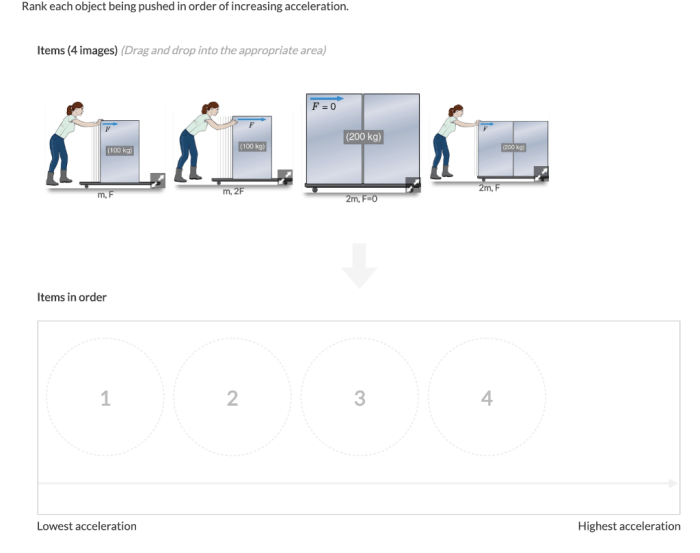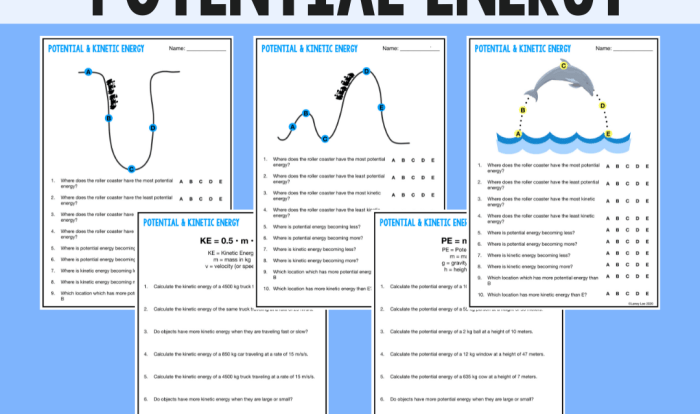Rank each object being pushed in order of increasing acceleration – In the realm of physics, acceleration plays a pivotal role in understanding the motion of objects. Understanding how to rank objects based on their acceleration is crucial for various applications in engineering, physics, and sports. This guide delves into the concept of acceleration, explores the factors influencing it, and provides a comprehensive framework for ranking objects based on their acceleration.
Acceleration, measured in meters per second squared (m/s²), quantifies the rate at which an object’s velocity changes over time. It is a vector quantity, possessing both magnitude and direction. The acceleration of an object is directly proportional to the net force acting upon it and inversely proportional to its mass.
Therefore, understanding the relationship between force, mass, and acceleration is essential for accurately ranking objects based on their acceleration.
Introduction

Acceleration, a measure of the rate of change in an object’s velocity, plays a pivotal role in understanding the motion and behavior of objects in the physical world. Ranking objects based on their acceleration provides valuable insights into their dynamic characteristics and allows for comparisons and optimizations in various applications.
Factors that influence the acceleration of an object include its mass, the force applied to it, and the opposing forces, such as friction and air resistance. By considering these factors, we can establish a comprehensive ranking system that accurately reflects the acceleration capabilities of different objects.
Methods for Ranking Objects
To facilitate the ranking of objects based on their acceleration, we employ a tabular format that encompasses four key parameters:
- Object Name: The identifier of the object being evaluated.
- Mass: The measure of the object’s resistance to acceleration.
- Force Applied: The external force acting upon the object, causing it to accelerate.
- Resulting Acceleration: The rate at which the object’s velocity changes as a consequence of the applied force.
This structured approach allows for a systematic comparison and ranking of objects, enabling us to draw meaningful conclusions about their acceleration characteristics.
Examples of Ranked Objects, Rank each object being pushed in order of increasing acceleration
To illustrate the concept of ranking objects based on acceleration, we present a diverse range of examples:
- Bullet Train:Characterized by exceptionally high acceleration, enabling rapid transit between cities.
- Race Car:Engineered for maximum acceleration, allowing for quick starts and overtaking maneuvers.
- Falling Object:Under the influence of gravity, objects in free fall exhibit constant acceleration towards the ground.
- Rocket:Propelling itself through the expulsion of exhaust, rockets achieve remarkable acceleration, making space exploration possible.
- Snail:Known for its slow and steady movement, snails exhibit minimal acceleration.
These examples showcase the wide spectrum of acceleration values found in the physical world, highlighting the importance of understanding and ranking objects based on this fundamental property.
Applications of Object Ranking
The ability to rank objects based on their acceleration finds practical applications in numerous fields:
- Engineering:Optimizing the design of vehicles, machines, and structures by considering acceleration factors.
- Physics:Studying the laws of motion and understanding the forces that govern acceleration.
- Sports:Analyzing the acceleration capabilities of athletes to enhance performance and training strategies.
- Safety:Evaluating the impact of acceleration on human bodies and designing protective measures.
- Space Exploration:Calculating the acceleration required for spacecraft to achieve orbital insertion and interplanetary travel.
By leveraging the knowledge gained from ranking objects based on acceleration, we can make informed decisions, improve designs, and enhance safety measures across a multitude of disciplines.
Limitations and Considerations
While ranking objects based on acceleration provides valuable insights, it is essential to acknowledge its limitations:
- Environmental Factors:External conditions such as air resistance and friction can affect the accuracy of acceleration measurements.
- Measurement Errors:Instrumentation and measurement techniques may introduce inaccuracies, impacting the reliability of ranking results.
- Assumptions:Rankings based on acceleration assume constant mass and force, which may not always hold true in real-world scenarios.
To address these limitations, researchers and practitioners employ advanced measurement techniques, refine experimental setups, and consider environmental factors to ensure the accuracy and reliability of object rankings based on acceleration.
FAQ Guide: Rank Each Object Being Pushed In Order Of Increasing Acceleration
What is the significance of ranking objects based on acceleration?
Ranking objects based on acceleration allows for the comparison and analysis of their motion under the influence of forces. It provides insights into the relative magnitudes of acceleration experienced by different objects, which is crucial for understanding their behavior and predicting their trajectories.
How does mass affect the acceleration of an object?
Mass is inversely proportional to acceleration, meaning that objects with greater mass experience lower acceleration for a given force. This is because mass represents the inertia of an object, which resists changes in its motion.
What are the limitations of ranking objects based solely on acceleration?
While ranking objects based on acceleration provides valuable information, it is important to consider its limitations. Factors such as environmental conditions, measurement errors, and the direction of acceleration can affect the accuracy of the ranking. Therefore, a comprehensive analysis should consider these factors to ensure reliable results.


